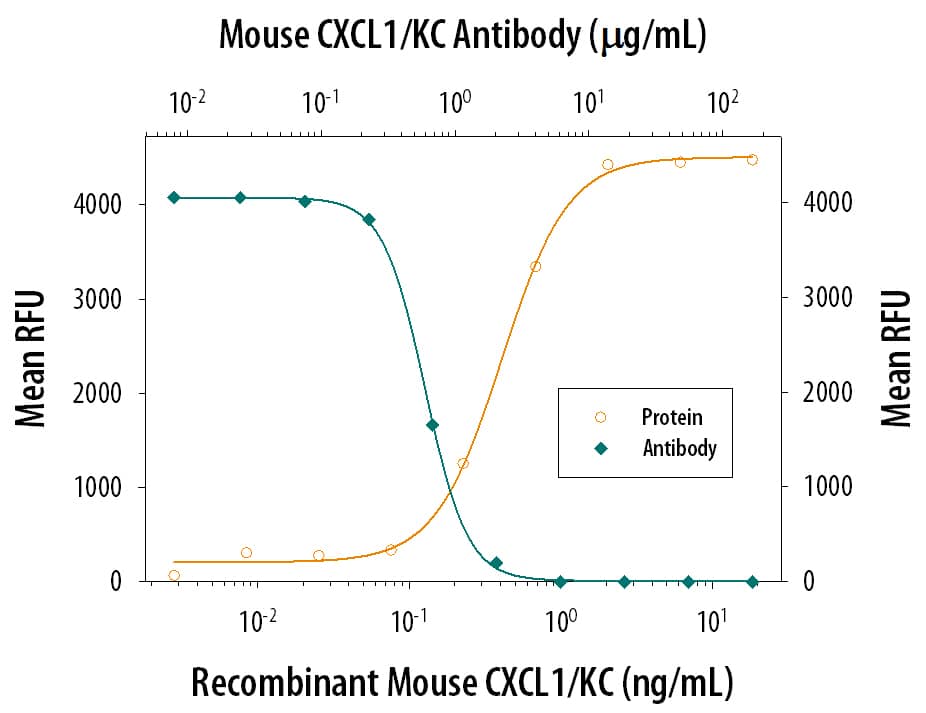Mouse CXCL1/GRO alpha/KC/CINC-1 Antibody
R&D Systems, part of Bio-Techne | Catalog # AF-453-NA


Key Product Details
Species Reactivity
Validated:
Mouse
Cited:
Mouse
Applications
Validated:
Neutralization, Western Blot
Cited:
Flow Cytometry, Immunocytochemistry, Immunohistochemistry, Immunohistochemistry-Frozen, Immunohistochemistry-Paraffin, In vivo assay, Neutralization, Western Blot
Label
Unconjugated
Antibody Source
Polyclonal Goat IgG
Product Specifications
Immunogen
E. coli-derived recombinant mouse CXCL1/GRO alpha/KC/CINC-1
Arg20-Lys96
Accession # P12850
Arg20-Lys96
Accession # P12850
Specificity
Detects mouse CXCL1/GRO alpha/KC/CINC-1 in direct ELISAs and Western blots.
Clonality
Polyclonal
Host
Goat
Isotype
IgG
Endotoxin Level
<0.10 EU per 1 μg of the antibody by the LAL method.
Scientific Data Images for Mouse CXCL1/GRO alpha/KC/CINC-1 Antibody
Chemotaxis Induced by CXCL1/KC and Neutralization by Mouse CXCL1/KC Antibody.
Recombinant Mouse CXCL1/KC (453-KC) chemoattracts the BaF3 mouse pro-B cell line transfected with human CXCR2 in a dose-dependent manner (orange line). The amount of cells that migrated through to the lower chemotaxis chamber was measured by Resazurin (AR002). Chemotaxis elicited by Recombinant Mouse CXCL1/KC (30 ng/mL) is neutralized (green line) by increasing concentrations of Goat Anti-Mouse CXCL1/KC Antigen Affinity-purified Polyclonal Antibody (Catalog # AF-453-NA). The ND50 is typically 0.3-1.5 µg/mL.Applications for Mouse CXCL1/GRO alpha/KC/CINC-1 Antibody
Application
Recommended Usage
Western Blot
0.1 µg/mL
Sample: Recombinant Mouse CXCL1/GRO alpha/KC/CINC-1 aa 20-96 (Catalog # 453-KC)
Sample: Recombinant Mouse CXCL1/GRO alpha/KC/CINC-1 aa 20-96 (Catalog # 453-KC)
Neutralization
Measured by its ability to neutralize CXCL1/GRO alpha/KC/CINC‑1-induced chemotaxis in the BaF3 mouse pro‑B cell line transfected with human CXCR2. The Neutralization Dose (ND50) is typically 0.3-1.5 µg/mL in the presence of 30 ng/mL Recombinant Mouse CXCL1/GRO alpha/KC/CINC‑1 aa 20‑96.
Formulation, Preparation, and Storage
Purification
Antigen Affinity-purified
Reconstitution
Reconstitute at 0.2 mg/mL in sterile PBS. For liquid material, refer to CoA for concentration.
Formulation
Lyophilized from a 0.2 μm filtered solution in PBS with Trehalose. *Small pack size (SP) is supplied either lyophilized or as a 0.2 µm filtered solution in PBS.
Shipping
Lyophilized product is shipped at ambient temperature. Liquid small pack size (-SP) is shipped with polar packs. Upon receipt, store immediately at the temperature recommended below.
Stability & Storage
Use a manual defrost freezer and avoid repeated freeze-thaw cycles.
- 12 months from date of receipt, -20 to -70 °C as supplied.
- 1 month, 2 to 8 °C under sterile conditions after reconstitution.
- 6 months, -20 to -70 °C under sterile conditions after reconstitution.
Background: CXCL1/GRO alpha/KC/CINC-1
Alternate Names
CINC-1, CINC1, GRO alpha, KC, MGSA-alpha
Gene Symbol
CXCL1
UniProt
Additional CXCL1/GRO alpha/KC/CINC-1 Products
Product Documents for Mouse CXCL1/GRO alpha/KC/CINC-1 Antibody
Product Specific Notices for Mouse CXCL1/GRO alpha/KC/CINC-1 Antibody
For research use only
